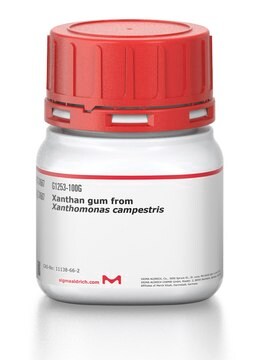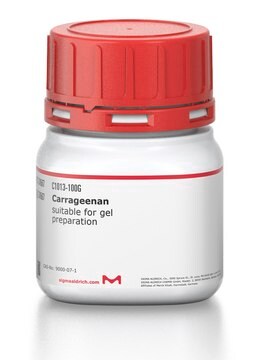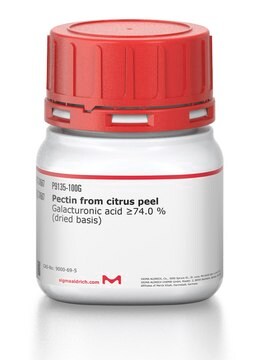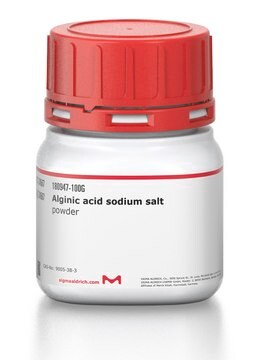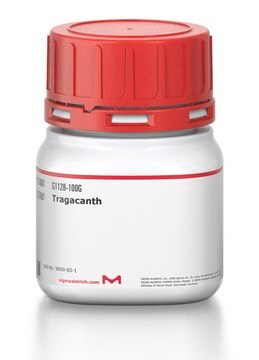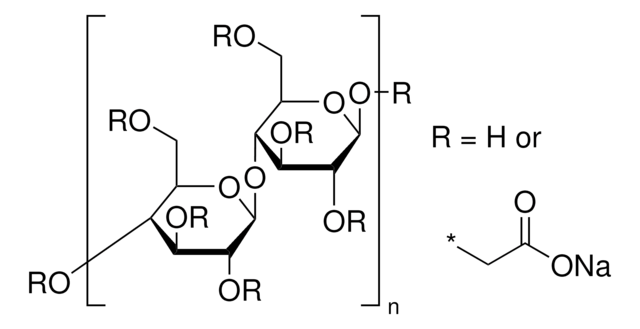G0753
Locust bean gum from Ceratonia siliqua seeds
Synonym(e):
Gum Locust Bean, Manno-Galactan (Hauptbestandteil), ‘Johannisbrotmehl’
Anmeldenzur Ansicht organisationsspezifischer und vertraglich vereinbarter Preise
Alle Fotos(2)
About This Item
Empfohlene Produkte
Biologische Quelle
Ceratonia siliqua seeds
Form
powder
Farbe
beige
Lagertemp.
room temp
Anwendung
Locust bean gum (LBG, galactomannan polysaccharide) from Ceratonia siliqua seeds may be used as a substrate to help identify, differentiate and characterize mannanase(s), such as the β-Mannanases (EC 3.2.1.78). LBG may be used in the development of drug delivery devices. LBG may be used to study its properties as a protective agent on both eucalyptus and microcrystalline cellulose destruction of crystallinity by ball milling. LBG may be used to study its properties as a food additive that reduces spoilage caused by Aspergillus flavus. LBG may be used as a starting material for the organic synthesis of hyperbranched N-glycan core structures.
Sonstige Hinweise
Believed to be a straight chain polymer of mannose with one galactose branch on every fourth mannose and a M.W. of approx. 310 kDa.
To gain a comprehensive understanding of our extensive range of Oligosaccharides for your research, we encourage you to visit our Carbohydrates Category page.
Lagerklassenschlüssel
11 - Combustible Solids
WGK
WGK 2
Flammpunkt (°F)
Not applicable
Flammpunkt (°C)
Not applicable
Persönliche Schutzausrüstung
Eyeshields, Gloves, type N95 (US)
Analysenzertifikate (COA)
Suchen Sie nach Analysenzertifikate (COA), indem Sie die Lot-/Chargennummer des Produkts eingeben. Lot- und Chargennummern sind auf dem Produktetikett hinter den Wörtern ‘Lot’ oder ‘Batch’ (Lot oder Charge) zu finden.
Besitzen Sie dieses Produkt bereits?
In der Dokumentenbibliothek finden Sie die Dokumentation zu den Produkten, die Sie kürzlich erworben haben.
Kunden haben sich ebenfalls angesehen
S Sánchez-Segado et al.
Bioresource technology, 104, 324-328 (2011-11-22)
A process for the production of ethanol from carob (Ceratonia siliqua) pods was designed and an economic analysis was carried out for a hypothetical plant. The plant was assumed to perform an aqueous extraction of sugars from the pods followed
Hossein Vaheed et al.
Journal of industrial microbiology & biotechnology, 38(1), 101-111 (2010-09-08)
In this research, ethanol production from carob pod extract (extract) using Zymomonas mobilis with medium optimized by Plackett-Burman (P-B) and response surface methodologies (RSM) was studied. Z. mobilis was recognized as useful for ethanol production from carob pod extract. The
T Mohammadi Moghaddam et al.
Journal of the science of food and agriculture, 91(6), 1083-1088 (2011-02-11)
Lallemantia royleana (Balangu) is a mucilaginous endemic plant which is grown in different regions of world. The flow behaviour of Balangu seed extract (BSE) and its mixture with xanthan, guar and locust bean gums at 1:3, 1:1 and 3:1 ratios
Camila P Favaro et al.
Biomolecules, 10(2) (2020-02-09)
Soluble coffee offers the combined benefits of high added value and practicality for its consumers. The hydrolysis of coffee polysaccharides by the biochemical route, using enzymes, is an eco-friendly and sustainable way to improve the quality of this product, while
B M Smith et al.
Journal of food science, 77(6), C684-C689 (2012-06-08)
Carob germ proteins have been shown to have functional properties similar to wheat gluten enabling formulation and production of yeast leavened gluten-free baked goods from a true dough rather than a stiff batter. The purpose of this research was to
Unser Team von Wissenschaftlern verfügt über Erfahrung in allen Forschungsbereichen einschließlich Life Science, Materialwissenschaften, chemischer Synthese, Chromatographie, Analytik und vielen mehr..
Setzen Sie sich mit dem technischen Dienst in Verbindung.